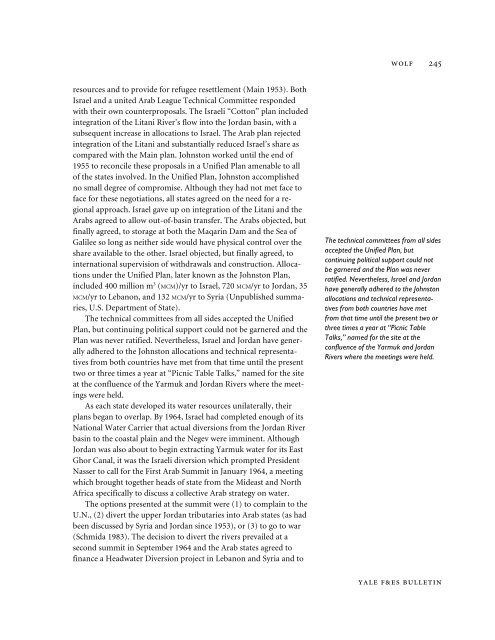Hydrostrategic Decisionmaking and the Arab ... - Yale University
Hydrostrategic Decisionmaking and the Arab ... - Yale University
Hydrostrategic Decisionmaking and the Arab ... - Yale University
Create successful ePaper yourself
Turn your PDF publications into a flip-book with our unique Google optimized e-Paper software.
WOLF 245resources <strong>and</strong> to provide for refugee resettlement (Main 1953). BothIsrael <strong>and</strong> a united <strong>Arab</strong> League Technical Committee respondedwith <strong>the</strong>ir own counterproposals. The Israeli “Cotton” plan includedintegration of <strong>the</strong> Litani River’s flow into <strong>the</strong> Jordan basin, with asubsequent increase in allocations to Israel. The <strong>Arab</strong> plan rejectedintegration of <strong>the</strong> Litani <strong>and</strong> substantially reduced Israel’s share ascompared with <strong>the</strong> Main plan. Johnston worked until <strong>the</strong> end of1955 to reconcile <strong>the</strong>se proposals in a Unified Plan amenable to allof <strong>the</strong> states involved. In <strong>the</strong> Unified Plan, Johnston accomplishedno small degree of compromise. Although <strong>the</strong>y had not met face toface for <strong>the</strong>se negotiations, all states agreed on <strong>the</strong> need for a regionalapproach. Israel gave up on integration of <strong>the</strong> Litani <strong>and</strong> <strong>the</strong><strong>Arab</strong>s agreed to allow out-of-basin transfer. The <strong>Arab</strong>s objected, butfinally agreed, to storage at both <strong>the</strong> Maqarin Dam <strong>and</strong> <strong>the</strong> Sea ofGalilee so long as nei<strong>the</strong>r side would have physical control over <strong>the</strong>share available to <strong>the</strong> o<strong>the</strong>r. Israel objected, but finally agreed, tointernational supervision of withdrawals <strong>and</strong> construction. Allocationsunder <strong>the</strong> Unified Plan, later known as <strong>the</strong> Johnston Plan,included 400 million m 3 (MCM)/yr to Israel, 720 MCM/yr to Jordan, 35MCM/yr to Lebanon, <strong>and</strong> 132 MCM/yr to Syria (Unpublished summaries,U.S. Department of State).The technical committees from all sides accepted <strong>the</strong> UnifiedPlan, but continuing political support could not be garnered <strong>and</strong> <strong>the</strong>Plan was never ratified. Never<strong>the</strong>less, Israel <strong>and</strong> Jordan have generallyadhered to <strong>the</strong> Johnston allocations <strong>and</strong> technical representativesfrom both countries have met from that time until <strong>the</strong> presenttwo or three times a year at “Picnic Table Talks,” named for <strong>the</strong> siteat <strong>the</strong> confluence of <strong>the</strong> Yarmuk <strong>and</strong> Jordan Rivers where <strong>the</strong> meetingswere held.As each state developed its water resources unilaterally, <strong>the</strong>irplans began to overlap. By 1964, Israel had completed enough of itsNational Water Carrier that actual diversions from <strong>the</strong> Jordan Riverbasin to <strong>the</strong> coastal plain <strong>and</strong> <strong>the</strong> Negev were imminent. AlthoughJordan was also about to begin extracting Yarmuk water for its EastGhor Canal, it was <strong>the</strong> Israeli diversion which prompted PresidentNasser to call for <strong>the</strong> First <strong>Arab</strong> Summit in January 1964, a meetingwhich brought toge<strong>the</strong>r heads of state from <strong>the</strong> Mideast <strong>and</strong> NorthAfrica specifically to discuss a collective <strong>Arab</strong> strategy on water.The options presented at <strong>the</strong> summit were (1) to complain to <strong>the</strong>U.N., (2) divert <strong>the</strong> upper Jordan tributaries into <strong>Arab</strong> states (as hadbeen discussed by Syria <strong>and</strong> Jordan since 1953), or (3) to go to war(Schmida 1983). The decision to divert <strong>the</strong> rivers prevailed at asecond summit in September 1964 <strong>and</strong> <strong>the</strong> <strong>Arab</strong> states agreed tofinance a Headwater Diversion project in Lebanon <strong>and</strong> Syria <strong>and</strong> toThe technical committees from all sidesaccepted <strong>the</strong> Unified Plan, butcontinuing political support could notbe garnered <strong>and</strong> <strong>the</strong> Plan was neverratified. Never<strong>the</strong>less, Israel <strong>and</strong> Jordanhave generally adhered to <strong>the</strong> Johnstonallocations <strong>and</strong> technical representativesfrom both countries have metfrom that time until <strong>the</strong> present two orthree times a year at “Picnic TableTalks,” named for <strong>the</strong> site at <strong>the</strong>confluence of <strong>the</strong> Yarmuk <strong>and</strong> JordanRivers where <strong>the</strong> meetings were held.YALE F&ES BULLETIN
















